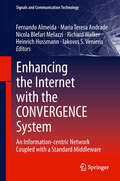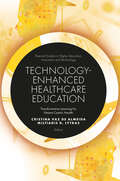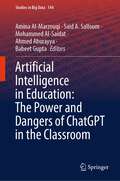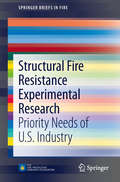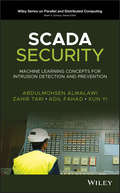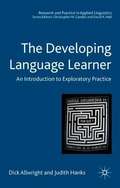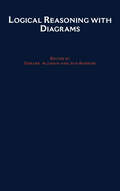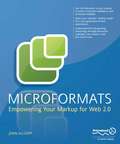- Table View
- List View
RoboCup 2015: Robot World Cup XIX (Lecture Notes in Computer Science #9513)
by Luis Almeida Jianmin Ji Gerald Steinbauer Sean LukeThis book is the Proceedings of the 19th Annual RoboCup International Symposium, held in Hefei, China, in July 2015.The book contains 20 papers presented at the Symposium, carefully selected from 39 submissions. Additionally the book contains 11 champion team papers and one paper from the Workshop on Benchmarking Service Robots. The papers present current research in robotics, artificial intelligence, computer vision, multiagent systems, simulation, and other areas.
Rigorous Software Development: An Introduction to Program Verification (Undergraduate Topics in Computer Science)
by José Bacelar Almeida Maria João Frade Jorge Sousa Pinto Simão Melo de SousaThe use of mathematical methods in the development of software is essential when reliable systems are sought; in particular they are now strongly recommended by the official norms adopted in the production of critical software. Program Verification is the area of computer science that studies mathematical methods for checking that a program conforms to its specification. This text is a self-contained introduction to program verification using logic-based methods, presented in the broader context of formal methods for software engineering. The idea of specifying the behaviour of individual software components by attaching contracts to them is now a widely followed approach in program development, which has given rise notably to the development of a number of behavioural interface specification languages and program verification tools. A foundation for the static verification of programs based on contract-annotated routines is laid out in the book. These can be independently verified, which provides a modular approach to the verification of software. The text assumes only basic knowledge of standard mathematical concepts that should be familiar to any computer science student. It includes a self-contained introduction to propositional logic and first-order reasoning with theories, followed by a study of program verification that combines theoretical and practical aspects - from a program logic (a variant of Hoare logic for programs containing user-provided annotations) to the use of a realistic tool for the verification of C programs (annotated using the ACSL specification language), through the generation of verification conditions and the static verification of runtime errors.
Profinite Semigroups and Symbolic Dynamics (Lecture Notes in Mathematics #2274)
by Jorge Almeida Alfredo Costa Revekka Kyriakoglou Dominique PerrinThis book describes the relation between profinite semigroups and symbolic dynamics. Profinite semigroups are topological semigroups which are compact and residually finite. In particular, free profinite semigroups can be seen as the completion of free semigroups with respect to the profinite metric. In this metric, two words are close if one needs a morphism on a large finite monoid to distinguish them. The main focus is on a natural correspondence between minimal shift spaces (closed shift-invariant sets of two-sided infinite words) and maximal J-classes (certain subsets of free profinite semigroups). This correspondence sheds light on many aspects of both profinite semigroups and symbolic dynamics. For example, the return words to a given word in a shift space can be related to the generators of the group of the corresponding J-class. The book is aimed at researchers and graduate students in mathematics or theoretical computer science.
Operational Research: IO 2013 - XVI Congress of APDIO, Bragança, Portugal, June 3-5, 2013 (CIM Series in Mathematical Sciences #4)
by João Paulo Almeida José Fernando Oliveira Alberto Adrego PintoThis volume presents selected contributions by top researchers in the field of operations research, originating from the XVI Congress of APDIO. It provides interesting findings and applications of operations research methods and techniques in a wide variety of problems. The contributions address complex real-world problems, including inventory management with lateral transshipments, sectors and routes in solid-waste collection and production planning for perishable food products. It also discusses the latest techniques, making the volume a valuable tool for researchers, students and practitioners who wish to learn about current trends. Of particular interest are the applications of nonlinear and mixed-integer programming, data envelopment analysis, clustering techniques, hybrid heuristics, supply chain management and lot sizing, as well as job scheduling problems.This biennial conference, organized by APDIO, the Portuguese Association of Operational Research, held in Bragança, Portugal, in June 2013, presented a perfect opportunity to discuss the latest development in this field and to narrow the gap between academic researchers and practitioners.
Hybrid Metaheuristics: Third International Workshop, HM 2006, Gran Canaria, Spain, October 13-14, 2006, Proceedings (Lecture Notes in Computer Science #4030)
by Francisco Almeida María J. Blesa Aguilera Christian Blum José Marcos Moreno Vega Melquíades Pérez Andrea Roli Michael SampelsThis book constitutes the refereed proceedings of the Third International Workshop on Hybrid Metaheuristics, HM 2006, held in Gran Canaria, Spain, in October 2006. The 13 revised full papers presented together with one invited paper were carefully reviewed and selected from 42 submissions.
Enhancing the Internet with the CONVERGENCE System: An Information-centric Network Coupled with a Standard Middleware (Signals and Communication Technology)
by Fernando Almeida Maria Teresa Andrade Nicola Blefari Melazzi Richard Walker Heinrich Hussmann Iakovos S. VenierisConvergence proposes the enhancement of the Internet with a novel, content-centric, publish–subscribe service model based on the versatile digital item (VDI): a common container for all kinds of digital content, including digital representations of real-world resources. VDIs will serve the needs of the future Internet, providing a homogeneous method for handling structured information, incorporating security and privacy mechanisms. CONVERGENCE subsumes the following areas of research:· definition of the VDI as a new fundamental unit of distribution and transaction;· content-centric networking functionality to complement or replace IP-address-based routing;· security and privacy protection mechanisms;· open-source middleware, including a community dictionary service to enable rich semantic searches;· applications, tested under real-life conditions.This book shows how CONVERGENCE allows publishing, searching and subscribing to any content. Creators can publish their content by wrapping it and its descriptions into a VDI, setting rights for other users to access this content, monitor its use, and communicate with people using it; they may even update or revoke content previously published. Access to content is more efficient, as search engines exploit VDI metadata for indexing, and the network uses the content name to ensure users always access the copy closest to them. Every node in the network is a content cache; handover is easy; multicast is natural; peer-to-peer is built-in; time/space-decoupling is possible. Application developers can exploit CONVERGENCE’s middleware and network without having to resort to proprietary/ad hoc solutions for common/supporting functionality. Operators can use the network more efficiently, better controlling information transfer and related revenues flows. Network design, operation and management are simplified by integrating diverse functions and avoiding patches and stopgap solutions.Whether as a text for graduate students working on the future of the Internet, or a resource for practitioners providing e-commerce or multimedia services, or scientists defining new technologies, CONVERGENCE will make a valuable contribution to the future shape of the Internet.
Technology-Enhanced Healthcare Education: Transformative Learning for Patient-Centric Health (Emerald Studies in Higher Education, Innovation and Technology)
by Cristina Vaz De Almeida Miltiadis D. LytrasThe new challenges in healthcare education require new methodological approaches and transparent integration of technology enhanced learning approaches. Technology-Enhanced Healthcare Education promotes the best practices and lessons learnt from COVID-19 and highlights the importance and impact of using information systems to increase levels of health literacy. The chapter authors cover processes such as augmented or virtual reality to allow for distraction and decreased anxiety of the patient and services such as telemedicine and tele-consultation in the follow-up of non-acute patients. These are just a few ways in which health professionals can utilise information systems and transformative technology to increase the quality of health care, levels of health literacy and, thus, increase the health outcomes of their patients. Technology-Enhanced Healthcare Education is an innovative volume for health specialists, educators, higher education medical experts, medical school students and health management professionals. It is key reading for those looking to learn more about the latest developments on active and transformative learning within health education and medical technology (MedTech).
Smart Technologies and Innovation for a Sustainable Future: Proceedings of the 1st American University in the Emirates International Research Conference — Dubai, UAE 2017 (Advances in Science, Technology & Innovation)
by Ahmed Al-Masri Kevin CurranThe book presents high-quality research papers presented at the 1st AUE International research conference, AUEIRC 2017, organized by the American University in the Emirates, held on November 15th-16th, 2017 in Dubai. The book is broadly divided into three sections: Media and Smart Cities, Creative Technologies and Innovation, and Security Risks and Strategic Challenges. The areas covered under these sections are cyber-psychology and digital forensics, cloud RAN architecture, networking functions virtualization, e-Governance and IoT semantic interoperability, ERP security, web-based application and problem-solving skills, smart technologies and advertising, smart technologies for smart cities, smart adaptable navigation systems, turbo codes for security key generation, technology advanced student learning and mobile devices, big data security and privacy, multi-channel buffer enabled technique, physiological signal acquisition in electro-oculography, blockchain and donation-based crowdfunding, smart city and framework development approach, news channel and media education, UAE foreign policy, China-GCC relations, diplomacy in the Internet age, intelligent cyber-security strategies, industry securities and strategic challenges, hybrid alliances and corporate security, security and privacy in smart cities, human computer interaction and e-learning solution, complexity of smart cities governance. The papers included in this book present insightful information on the most recent and relevant research, theories and practices in the field, which aim for a sustainable future.
Languages and Compilers for Parallel Computing: 19th International Workshop, LCPC 2006, New Orleans, LA, USA, November 2-4, 2006, Revised Papers (Lecture Notes in Computer Science #4382)
by Gheorghe Almási Calin Cascaval Peng WuThis book constitutes the thoroughly refereed post-proceedings of the 19th International Workshop on Languages and Compilers for Parallel Computing, LCPC 2006, held in New Orleans, LA, USA in November 2006. The 24 revised full papers presented together with two keynote talks cover programming models, code generation, parallelism, compilation techniques, data structures, register allocation, and memory management.
Artificial Intelligence in Education: The Power and Dangers of ChatGPT in the Classroom (Studies in Big Data #144)
by Amina Al-Marzouqi Said A. Salloum Mohammed Al-Saidat Ahmed Aburayya Babeet GuptaThis book aims to bring together a collection of innovative and cutting-edge research that addresses the various challenges in the application and theoretical aspects of ChatGPT in education. ChatGPT is a large language model developed by OpenAI that has the ability to generate human-like text based on a prompt. This has significant potential for use in the field of education, as it allows for the creation of personalized, interactive learning experiences, automating assessment and grading, and more. In e-learning, ChatGPT is used to provide instant feedback and support to students, as well as generate interactive conversations in the target language for language learning. It is also integrated with existing learning management systems and educational technology platforms to enhance their capabilities. In research, ChatGPT is used for natural language processing and sentiment analysis to gather insights on student learning experiences and educational outcomes. However, it is important to note that there are also ethical and privacy concerns that come with using language models like ChatGPT in education, such as data protection and the potential for bias. Overall, the use of ChatGPT in education has the potential to revolutionize the way we learn, teach, and access information. The book seeks to publish original manuscripts that cover a broad range of topics, from the development of new chatbot technologies and their integration into the classroom, to the examination of the ethical and pedagogical implications of these systems. By compiling the latest developments in the field and highlighting new areas for exploration, this book provides valuable insights and perspectives for researchers, educators, and practitioners working in the field of ChatGPT and education. The ultimate goal is to advance the understanding of ChatGPT and its role in education and to promote its effective and responsible use in the classroom and beyond.
Structural Fire Resistance Experimental Research: Priority Needs of U.S. Industry (SpringerBriefs in Fire)
by Kathleen H AlmandStructural Fire Resistance Experimental Research – Priority Needs of U.S. Industry provides a synthesis of stakeholder input to a prioritized agenda for research at the National Fire Research Laboratory (NFRL) at the National Institute of Standards and Technology (NIST) designed to accelerate the implementation of performance-based fire engineering for structures. The NFRL presents a broad range of unanswered questions regarding the performance of real structures in fire conditions, and informs performance-based design methods and standards in this field. The authors conducted a comprehensive literature review of large-scale structural fire testing and compiled research needs from a variety of sources. The book addresses major issues of broad concern in the fire community, such as real fire exposure and structural response, composite floor system performance, enhancing modeling performance, and understanding the embedded safety features in design methods. It concludes with a prioritized set of research recommendations for the NIST facility. The scope of issues addressed and broad range of content make this a valuable book for researchers in all aspects of fire resistance experimentation. It will also be useful for those who work with engineering standards for structures.
MOOCs Now: Everything You Need to Know to Design, Set Up, and Run a Massive Open Online Course
by Susan W. Alman Jennifer JumbaLearn from experts who have created and presented Massive Open Online Courses (MOOCs) that can reach a vast audience, and discover how to develop and present this new online form of continuing education.MOOCs (Massive Open Online Courses) have become popular with eager learners as well as some educators wanting to test the boundaries of learning. Understandably, many educators approach MOOCs with trepidation and a number of questions. Are MOOCs simply a fad? Does this new venue threaten traditional higher education models? How are teachers to be remunerated for their efforts? And what can be done about student retention in an anonymous venue of a MOOC?This book answers these questions and many more, offering a practical and realistic guide to MOOCs—one that will help anyone involved in higher education to better understand MOOCs and enable them to make decisions about whether and how to offer MOOCs. The authors address topics such as the various costs of offering a MOOC (teachers, developers, licensing, and software), explain accessibility options, examine the challenges of copyright and the administration required, and explore what the librarian's role should be. This insightful guide also explains your options for the presentation of text, video, and audio content; whether to give assignments or tests; and how to decide whether you should offer your MOOC for free or require a fee and offer a certificate upon course completion.
SCADA Security: Machine Learning Concepts for Intrusion Detection and Prevention (Wiley Series on Parallel and Distributed Computing)
by Abdulmohsen Almalawi Zahir Tari Adil Fahad Xun YiExamines the design and use of Intrusion Detection Systems (IDS) to secure Supervisory Control and Data Acquisition (SCADA) systems Cyber-attacks on SCADA systems—the control system architecture that uses computers, networked data communications, and graphical user interfaces for high-level process supervisory management—can lead to costly financial consequences or even result in loss of life. Minimizing potential risks and responding to malicious actions requires innovative approaches for monitoring SCADA systems and protecting them from targeted attacks. SCADA Security: Machine Learning Concepts for Intrusion Detection and Prevention is designed to help security and networking professionals develop and deploy accurate and effective Intrusion Detection Systems (IDS) for SCADA systems that leverage autonomous machine learning. Providing expert insights, practical advice, and up-to-date coverage of developments in SCADA security, this authoritative guide presents a new approach for efficient unsupervised IDS driven by SCADA-specific data. Organized into eight in-depth chapters, the text first discusses how traditional IT attacks can also be possible against SCADA, and describes essential SCADA concepts, systems, architectures, and main components. Following chapters introduce various SCADA security frameworks and approaches, including evaluating security with virtualization-based SCADAVT, using SDAD to extract proximity-based detection, finding a global and efficient anomaly threshold with GATUD, and more. This important book: Provides diverse perspectives on establishing an efficient IDS approach that can be implemented in SCADA systems Describes the relationship between main components and three generations of SCADA systems Explains the classification of a SCADA IDS based on its architecture and implementation Surveys the current literature in the field and suggests possible directions for future research SCADA Security: Machine Learning Concepts for Intrusion Detection and Prevention is a must-read for all SCADA security and networking researchers, engineers, system architects, developers, managers, lecturers, and other SCADA security industry practitioners.
SCADA Security: Machine Learning Concepts for Intrusion Detection and Prevention (Wiley Series on Parallel and Distributed Computing)
by Abdulmohsen Almalawi Zahir Tari Adil Fahad Xun YiExamines the design and use of Intrusion Detection Systems (IDS) to secure Supervisory Control and Data Acquisition (SCADA) systems Cyber-attacks on SCADA systems—the control system architecture that uses computers, networked data communications, and graphical user interfaces for high-level process supervisory management—can lead to costly financial consequences or even result in loss of life. Minimizing potential risks and responding to malicious actions requires innovative approaches for monitoring SCADA systems and protecting them from targeted attacks. SCADA Security: Machine Learning Concepts for Intrusion Detection and Prevention is designed to help security and networking professionals develop and deploy accurate and effective Intrusion Detection Systems (IDS) for SCADA systems that leverage autonomous machine learning. Providing expert insights, practical advice, and up-to-date coverage of developments in SCADA security, this authoritative guide presents a new approach for efficient unsupervised IDS driven by SCADA-specific data. Organized into eight in-depth chapters, the text first discusses how traditional IT attacks can also be possible against SCADA, and describes essential SCADA concepts, systems, architectures, and main components. Following chapters introduce various SCADA security frameworks and approaches, including evaluating security with virtualization-based SCADAVT, using SDAD to extract proximity-based detection, finding a global and efficient anomaly threshold with GATUD, and more. This important book: Provides diverse perspectives on establishing an efficient IDS approach that can be implemented in SCADA systems Describes the relationship between main components and three generations of SCADA systems Explains the classification of a SCADA IDS based on its architecture and implementation Surveys the current literature in the field and suggests possible directions for future research SCADA Security: Machine Learning Concepts for Intrusion Detection and Prevention is a must-read for all SCADA security and networking researchers, engineers, system architects, developers, managers, lecturers, and other SCADA security industry practitioners.
Advances in Wireless, Mobile Networks and Applications: International Conferences, WiMoA 2011 and ICCSEA 2011, Dubai, United Arab Emirates, May 25-27, 2011. Proceedings (Communications in Computer and Information Science #154)
by Salah S. Al-Majeed Chih-Lin Hu Dhinaharan NagamalaiThis book constitutes the refereed proceedings of the Third International Conference on Wireless, Mobile Networks and Applications, WiMoA 2011, and the First International Conference on Computer Science, Engineering and Applications, ICCSEA 2011, held in Dubai, United Arab Emirates, in May 2011. The book is organized as a collection of papers from WiMoA 2011 and ICCSEA 2011. The 8 revised full papers presented in the WiMoA 2011 part were carefully reviewed and selected from 63 submissions. The 20 revised full papers presented in the ICCSEA 2011 part were carefully reviewed and selected from 110 submissions.
Circuit Design and Simulation Quick Start Guide: Create Schematics and Layout Electronic Components (Maker Innovations Series)
by Ashraf Said AlMadhounOpen up the exciting world of electronics with 3D circuit designing tools and create your own fresh new projects. With this quick guide you’ll use high-quality graphical programs to create, modify, and update circuits in an interactive, virtual environment that can also be used in the real world. Follow along with the tutorials and get the chance to play with electronics safely before getting your hands dirty. In just a few minutes, you’ll start creating your first circuit. You’ll focus more on how the components layout together than on worrying about design to get started. Watch as different electronic components receive different signals and test them in different situations and circuit conditions first before moving on to real-life testing. When you’re ready, you’ll work with real breadboards and microcontrollers, such as the Arduino, to bring your simulated circuits and projects to life. Once you have your circuit put together, work with basic Arduino programming to give it purpose and make it respond to your commands. By the end of the book you'll have mastered the basics of both circuit design and programming. What You'll LearnEngineer electrical equipment for little to no costMeasure different electrical signals, such as voltage, temperature, light, and moreProgram Arduinos to work with your new circuitsWho This Book Is ForStudents and hobbyists interested in electrical engineering and programming who want to dive into experimentation virtually before working with real-world circuits.
The Developing Language Learner: An Introduction To Exploratory Practice (PDF)
by Dick Allwright Judith HanksThis book-length treatment of Exploratory Practice introduces five propositions about learners as practitioners of learning who are capable of developing their expertise through conducting research in and on their own classroom learning lives.
Logical Reasoning with Diagrams (Studies in Logic and Computation)
by Gerard Allwein Jon BarwiseOne effect of information technology is the increasing need to present information visually. The trend raises intriguing questions. What is the logical status of reasoning that employs visualization? What are the cognitive advantages and pitfalls of this reasoning? What kinds of tools can be developed to aid in the use of visual representation? This newest volume on the Studies in Logic and Computation series addresses the logical aspects of the visualization of information. The authors of these specially commissioned papers explore the properties of diagrams, charts, and maps, and their use in problem solving and teaching basic reasoning skills. As computers make visual representations more commonplace, it is important for professionals, researchers and students in computer science, philosophy, and logic to develop an understanding of these tools; this book can clarify the relationship between visuals and information.
Advanced Penetration Testing: Hacking the World's Most Secure Networks
by Wil AllsoppBuild a better defense against motivated, organized, professional attacks Advanced Penetration Testing: Hacking the World's Most Secure Networks takes hacking far beyond Kali linux and Metasploit to provide a more complex attack simulation. Featuring techniques not taught in any certification prep or covered by common defensive scanners, this book integrates social engineering, programming, and vulnerability exploits into a multidisciplinary approach for targeting and compromising high security environments. From discovering and creating attack vectors, and moving unseen through a target enterprise, to establishing command and exfiltrating data—even from organizations without a direct Internet connection—this guide contains the crucial techniques that provide a more accurate picture of your system's defense. Custom coding examples use VBA, Windows Scripting Host, C, Java, JavaScript, Flash, and more, with coverage of standard library applications and the use of scanning tools to bypass common defensive measures. Typical penetration testing consists of low-level hackers attacking a system with a list of known vulnerabilities, and defenders preventing those hacks using an equally well-known list of defensive scans. The professional hackers and nation states on the forefront of today's threats operate at a much more complex level—and this book shows you how to defend your high security network. Use targeted social engineering pretexts to create the initial compromise Leave a command and control structure in place for long-term access Escalate privilege and breach networks, operating systems, and trust structures Infiltrate further using harvested credentials while expanding control Today's threats are organized, professionally-run, and very much for-profit. Financial institutions, health care organizations, law enforcement, government agencies, and other high-value targets need to harden their IT infrastructure and human capital against targeted advanced attacks from motivated professionals. Advanced Penetration Testing goes beyond Kali linux and Metasploit and to provide you advanced pen testing for high security networks.
Advanced Penetration Testing: Hacking the World's Most Secure Networks
by Wil AllsoppBuild a better defense against motivated, organized, professional attacks Advanced Penetration Testing: Hacking the World's Most Secure Networks takes hacking far beyond Kali linux and Metasploit to provide a more complex attack simulation. Featuring techniques not taught in any certification prep or covered by common defensive scanners, this book integrates social engineering, programming, and vulnerability exploits into a multidisciplinary approach for targeting and compromising high security environments. From discovering and creating attack vectors, and moving unseen through a target enterprise, to establishing command and exfiltrating data—even from organizations without a direct Internet connection—this guide contains the crucial techniques that provide a more accurate picture of your system's defense. Custom coding examples use VBA, Windows Scripting Host, C, Java, JavaScript, Flash, and more, with coverage of standard library applications and the use of scanning tools to bypass common defensive measures. Typical penetration testing consists of low-level hackers attacking a system with a list of known vulnerabilities, and defenders preventing those hacks using an equally well-known list of defensive scans. The professional hackers and nation states on the forefront of today's threats operate at a much more complex level—and this book shows you how to defend your high security network. Use targeted social engineering pretexts to create the initial compromise Leave a command and control structure in place for long-term access Escalate privilege and breach networks, operating systems, and trust structures Infiltrate further using harvested credentials while expanding control Today's threats are organized, professionally-run, and very much for-profit. Financial institutions, health care organizations, law enforcement, government agencies, and other high-value targets need to harden their IT infrastructure and human capital against targeted advanced attacks from motivated professionals. Advanced Penetration Testing goes beyond Kali linux and Metasploit and to provide you advanced pen testing for high security networks.
Unauthorised Access: Physical Penetration Testing For IT Security Teams
by Wil AllsoppThe first guide to planning and performing a physical penetration test on your computer's security Most IT security teams concentrate on keeping networks and systems safe from attacks from the outside-but what if your attacker was on the inside? While nearly all IT teams perform a variety of network and application penetration testing procedures, an audit and test of the physical location has not been as prevalent. IT teams are now increasingly requesting physical penetration tests, but there is little available in terms of training. The goal of the test is to demonstrate any deficiencies in operating procedures concerning physical security. Featuring a Foreword written by world-renowned hacker Kevin D. Mitnick and lead author of The Art of Intrusion and The Art of Deception, this book is the first guide to planning and performing a physical penetration test. Inside, IT security expert Wil Allsopp guides you through the entire process from gathering intelligence, getting inside, dealing with threats, staying hidden (often in plain sight), and getting access to networks and data. Teaches IT security teams how to break into their own facility in order to defend against such attacks, which is often overlooked by IT security teams but is of critical importance Deals with intelligence gathering, such as getting access building blueprints and satellite imagery, hacking security cameras, planting bugs, and eavesdropping on security channels Includes safeguards for consultants paid to probe facilities unbeknown to staff Covers preparing the report and presenting it to management In order to defend data, you need to think like a thief-let Unauthorised Access show you how to get inside.
Unauthorised Access: Physical Penetration Testing For IT Security Teams
by Wil AllsoppThe first guide to planning and performing a physical penetration test on your computer's security Most IT security teams concentrate on keeping networks and systems safe from attacks from the outside-but what if your attacker was on the inside? While nearly all IT teams perform a variety of network and application penetration testing procedures, an audit and test of the physical location has not been as prevalent. IT teams are now increasingly requesting physical penetration tests, but there is little available in terms of training. The goal of the test is to demonstrate any deficiencies in operating procedures concerning physical security. Featuring a Foreword written by world-renowned hacker Kevin D. Mitnick and lead author of The Art of Intrusion and The Art of Deception, this book is the first guide to planning and performing a physical penetration test. Inside, IT security expert Wil Allsopp guides you through the entire process from gathering intelligence, getting inside, dealing with threats, staying hidden (often in plain sight), and getting access to networks and data. Teaches IT security teams how to break into their own facility in order to defend against such attacks, which is often overlooked by IT security teams but is of critical importance Deals with intelligence gathering, such as getting access building blueprints and satellite imagery, hacking security cameras, planting bugs, and eavesdropping on security channels Includes safeguards for consultants paid to probe facilities unbeknown to staff Covers preparing the report and presenting it to management In order to defend data, you need to think like a thief-let Unauthorised Access show you how to get inside.
Microformats: Empowering Your Markup for Web 2.0
by John AllsoppIn this book, noted web developer and long time WaSP member John Allsop offers practical examples to teach all you need to know about Microformats. Coverage details what Microformats are currently available and how to use them; the general principles of how they work; how to use Microformats with web sites and software that already support them; and how to create your own. The end of the book features a chapter full of anecdotes from many professional web designers and developers already using Microformats in their work today--what worked, what didn't, things to watch for--so you can learn from their experiences.
Clean Code in C#: Refactor your legacy C# code base and improve application performance by applying best practices
by Jason AllsDevelop your programming skills by exploring essential topics such as code reviews, implementing TDD and BDD, and designing APIs to overcome code inefficiency, redundancy, and other problems arising from bad code Key Features Write code that cleanly integrates with other systems while maintaining well-defined software boundaries Understand how coding principles and standards enhance software quality Learn how to avoid common errors while implementing concurrency or threading Book Description Traditionally associated with developing Windows desktop applications and games, C# is now used in a wide variety of domains, such as web and cloud apps, and has become increasingly popular for mobile development. Despite its extensive coding features, professionals experience problems related to efficiency, scalability, and maintainability because of bad code. Clean Code in C# will help you identify these problems and solve them using coding best practices. The book starts with a comparison of good and bad code, helping you understand the importance of coding standards, principles, and methodologies. You'll then get to grips with code reviews and their role in improving your code while ensuring that you adhere to industry-recognized coding standards. This C# book covers unit testing, delves into test-driven development, and addresses cross-cutting concerns. You'll explore good programming practices for objects, data structures, exception handling, and other aspects of writing C# computer programs. Once you've studied API design and discovered tools for improving code quality, you'll look at examples of bad code and understand which coding practices you should avoid. By the end of this clean code book, you'll have the developed skills you need in order to apply industry-approved coding practices to write clean, readable, extendable, and maintainable C# code. What you will learn Write code that allows software to be modified and adapted over time Implement the fail-pass-refactor methodology using a sample C# console application Address cross-cutting concerns with the help of software design patterns Write custom C# exceptions that provide meaningful information Identify poor quality C# code that needs to be refactored Secure APIs with API keys and protect data using Azure Key Vault Improve your code's performance by using tools for profiling and refactoring Who this book is for This coding book is for C# developers, team leads, senior software engineers, and software architects who want to improve the efficiency of their legacy systems. A strong understanding of C# programming is required.





